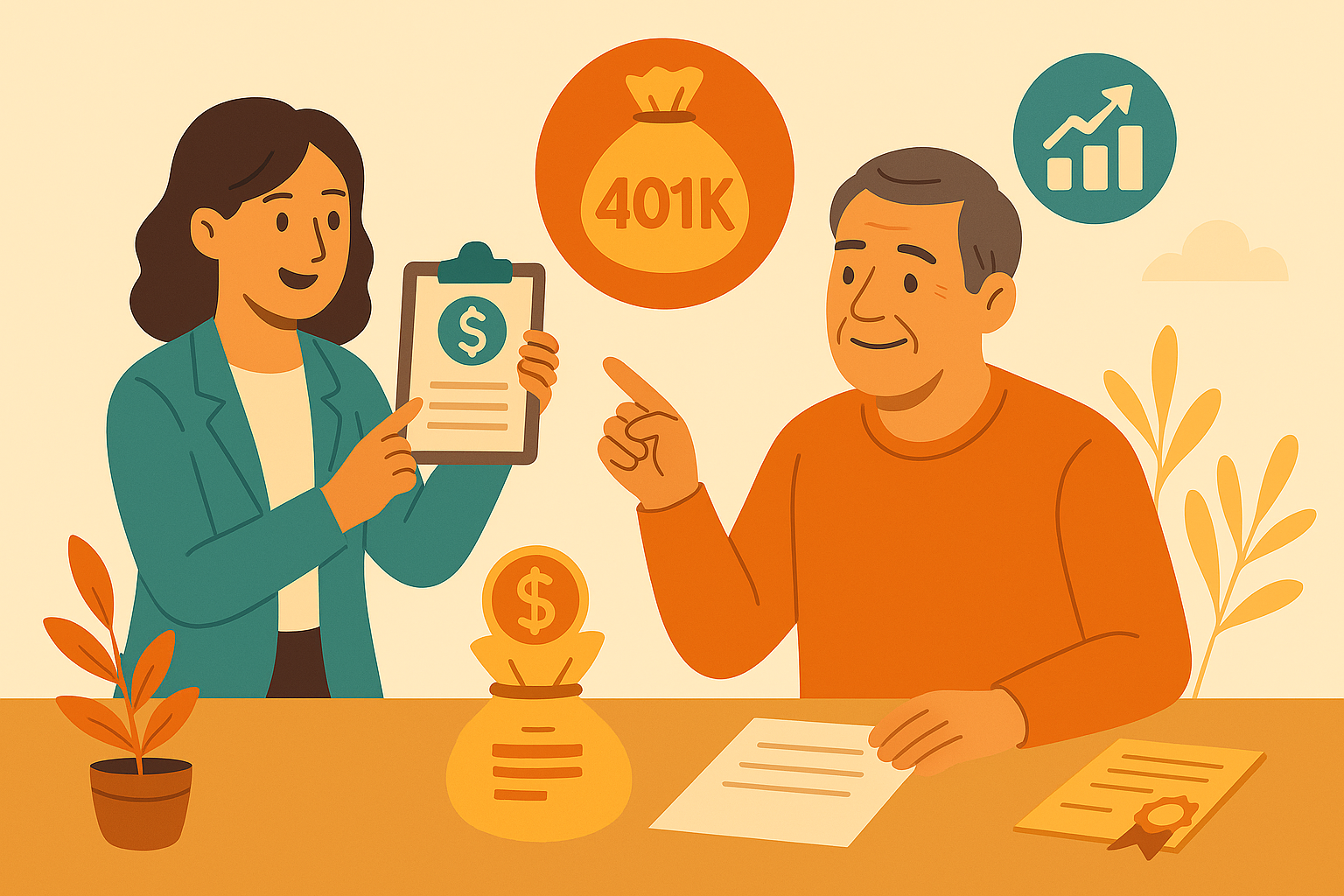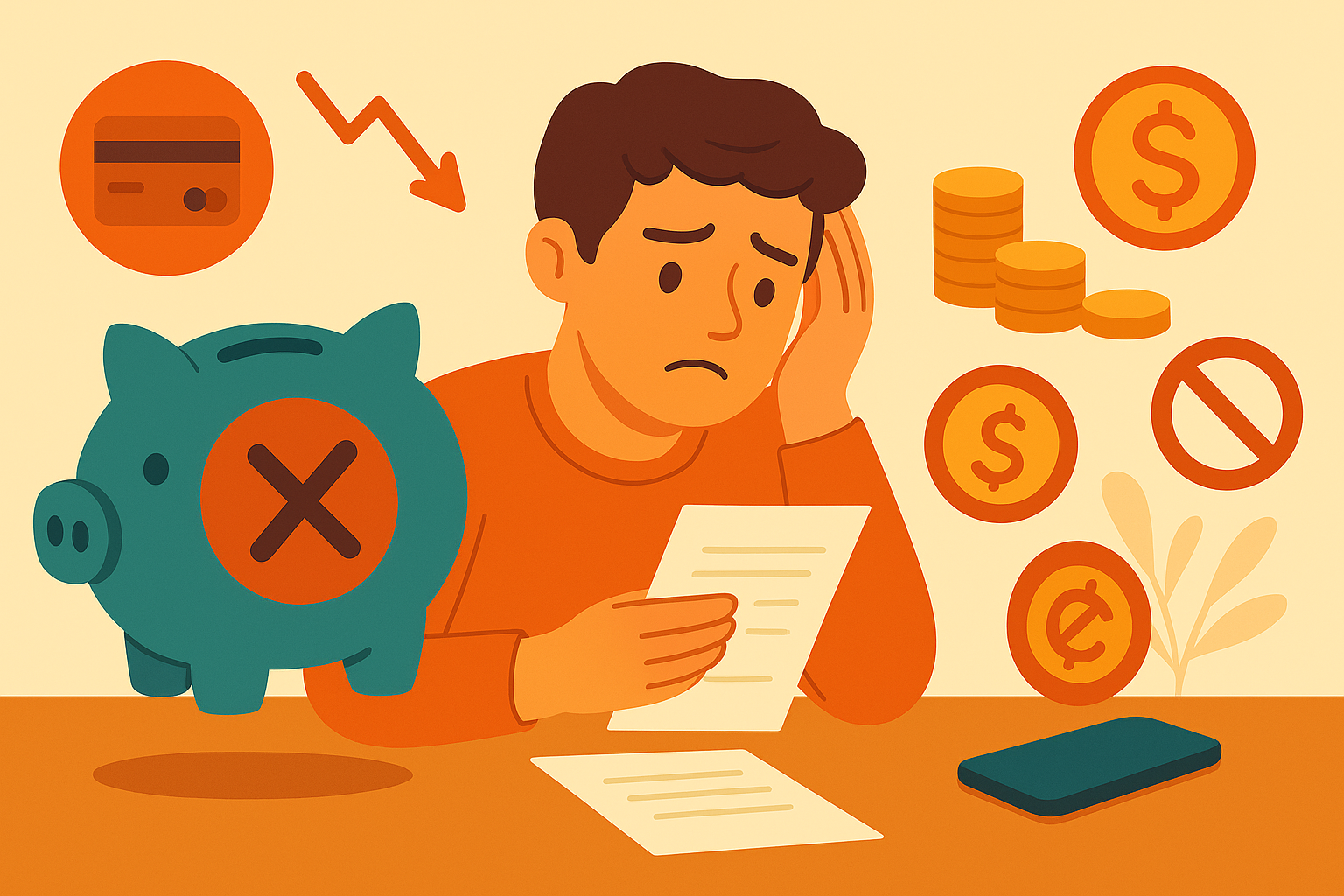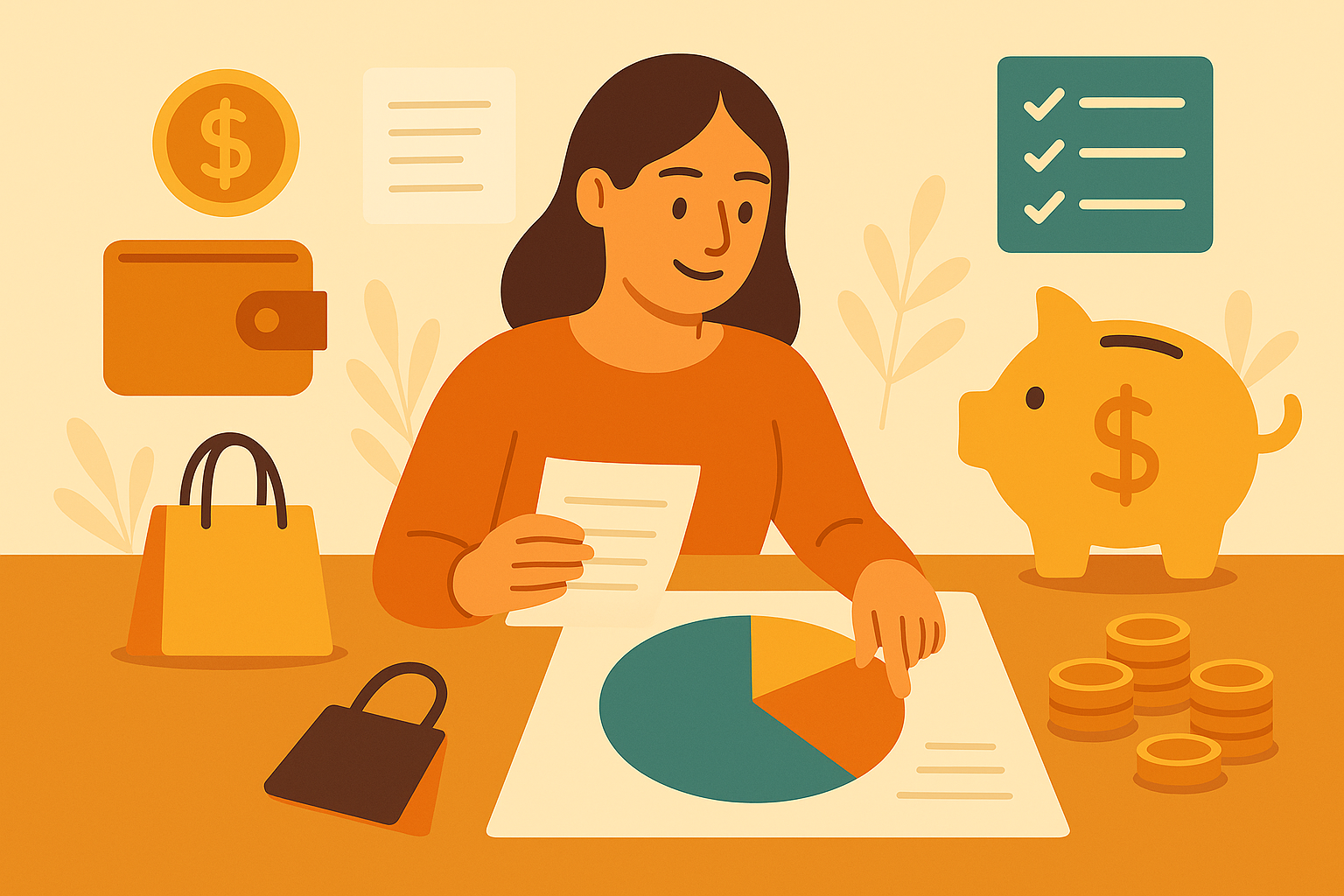Hey friend! So you just started a new job (congrats!), and during orientation, someone mentioned something about a “401(k)” and “employer match” and “vesting schedules.” You nodded along like you totally understood, but honestly? You have no idea what any of that means.
Don’t worry – I was in the exact same boat a few years ago. I actually ignored my 401(k) for an entire year because it seemed too complicated and I thought I couldn’t afford it. Looking back, that was one of my biggest financial mistakes. I literally left thousands of dollars on the table.
Today, I’m going to break down everything you need to know about 401(k)s in plain English. No confusing jargon, no boring corporate speak – just real talk about what a 401(k) is, how it works, and why you should absolutely be using one (even if you’re barely making ends meet).
What Even Is a 401(k)?
Let’s start with the basics. A 401(k) is a retirement savings account that your employer offers. It’s named after a section of the tax code (I know, super exciting), but don’t let that intimidate you.
Here’s how it works in the simplest terms possible: Every paycheck, you can choose to put some of your money into your 401(k) instead of taking it home. That money gets invested in things like stocks and bonds, and it grows over time until you retire.
The cool part? The money goes in before taxes are taken out, which means you pay less in taxes right now. So if you make $50,000 a year and put $5,000 into your 401(k), the IRS only taxes you on $45,000. Pretty neat, right?
When I first learned this, my mind was blown. I’d been paying taxes on my full salary and then trying to save from what was left over. With a 401(k), you save first and pay taxes later (when you withdraw the money in retirement).
The Magic of Employer Matching (AKA Free Money)
Okay, here’s where it gets really good. Many employers offer something called “matching contributions.” This is literally the closest thing to free money that exists in personal finance.
Here’s how it typically works: Your employer says something like “We’ll match 50% of your contributions up to 6% of your salary.” Let me break that down with real numbers because that sentence used to make my eyes glaze over.
Example time:
- You make $50,000 a year
- You contribute 6% of your salary = $3,000 per year
- Your employer matches 50% of that = $1,500
- Total going into your 401(k) = $4,500
Your employer just gave you $1,500 for free. You didn’t have to work extra hours for it. You didn’t have to negotiate for it. You just had to participate in the 401(k) plan.
My personal story: When I finally signed up for my 401(k) after ignoring it for a year, I realized my employer was offering a 50% match up to 6%. I did the math and nearly cried. I had missed out on about $2,400 of free money that first year. That $2,400, if invested for 30 years at 8% annual returns, would have grown to over $24,000. All because I thought I was “too broke” to contribute.
Don’t be like young me. If your employer offers any kind of match, you need to contribute at least enough to get the full match. It’s an instant 50% or 100% return on your money. You literally cannot find that anywhere else.
How Much Should You Contribute?
This is the question everyone asks, and honestly, the answer depends on your situation. But here’s my general framework:
Bare minimum: Contribute enough to get the full employer match. If your employer matches up to 6%, contribute 6%. This is non-negotiable unless you’re in serious financial crisis.
Good target: Try to work up to 10-15% of your salary (including employer match). So if you contribute 10% and your employer adds 3%, you’re at 13% total. This puts you on track for a comfortable retirement.
Ideal scenario: Max out your 401(k) completely. For 2024, the limit is $23,000 per year (or $30,500 if you’re 50 or older). Obviously, not everyone can do this, and that’s totally fine.
When I started, I could only afford 3% of my salary. Then I gave myself a raise every year – 4%, then 5%, then 6%. Now I’m at 10%, and honestly, I don’t even miss the money because the increases were gradual. Start where you can and increase it over time.
Pre-Tax vs. Roth 401(k): Which Should You Choose?
Some employers offer both a traditional (pre-tax) 401(k) and a Roth 401(k). This confused the heck out of me at first, so let me simplify it.
Traditional 401(k) (Pre-tax):
- Money goes in before taxes
- You pay less in taxes now
- You pay taxes when you withdraw in retirement
Roth 401(k):
- Money goes in after taxes
- You pay normal taxes now
- Withdrawals in retirement are completely tax-free
Which one should you choose? Here’s my personal rule of thumb:
If you’re young and in a relatively low tax bracket (making under $60,000-ish), go Roth. You’ll pay taxes now while your rate is low, and then enjoy tax-free withdrawals when you’re (hopefully) making more money in retirement.
If you’re in a higher tax bracket now, traditional might make more sense because the tax deduction provides immediate relief.
Personally, I do a mix of both. I put most of my money in Roth because I expect to be in a higher tax bracket when I retire, but I also contribute some to traditional to lower my taxes a bit now. There’s no wrong answer here – something is always better than nothing.
What Actually Happens to Your Money?
When you contribute to your 401(k), that money doesn’t just sit there in cash. It gets invested. Your employer will give you a list of investment options – usually a bunch of mutual funds with confusing names.
This is where a lot of people get overwhelmed and just pick something random or don’t sign up at all. Let me make this super simple for you.
Look for one of these options:
- Target-date fund (like “Target Date 2060 Fund” if you plan to retire around 2060)
- S&P 500 index fund
- Total stock market index fund
Target-date funds are perfect for beginners because they automatically adjust as you get older. When you’re young, they invest more in stocks (higher risk, higher returns). As you approach retirement, they gradually shift to more bonds (lower risk, more stable). It’s literally a “set it and forget it” option.
I started with a target-date fund and honestly, it was the best decision. I didn’t have to think about rebalancing or adjusting my allocation. The fund did it all for me.
What to avoid: Any fund with “expenses” or “fees” over 1%. Those high fees will eat your returns alive over time. Look for index funds with expense ratios under 0.5%, ideally under 0.2%.
Understanding Vesting (And Why It Matters)
Here’s something that caught me off guard: employer contributions often come with something called a “vesting schedule.”
What is vesting? It’s basically your employer’s way of encouraging you to stick around. The money YOU contribute is always 100% yours. But the money your EMPLOYER contributes might not be fully yours until you’ve worked there for a certain amount of time.
Common vesting schedules:
- Immediate vesting: Employer match is yours right away (best scenario)
- Cliff vesting: You get 0% until you hit a certain anniversary (like 3 years), then suddenly it’s 100% yours
- Graded vesting: You gradually own more each year (20% after year 1, 40% after year 2, etc.)
When I left my first job after 2.5 years, I had a 3-year cliff vesting schedule. I lost all of my employer contributions because I left six months too early. It was about $4,000 down the drain. Learn from my mistake – know your vesting schedule before you quit a job!
When Can You Actually Use This Money?
The general rule is that you can’t touch your 401(k) money until you’re 59½ years old without paying a penalty. If you withdraw before that, you’ll pay regular income taxes PLUS a 10% early withdrawal penalty.
But there are exceptions:
- If you leave your job in the year you turn 55 or later, you can access that specific 401(k) penalty-free
- You can take loans from your 401(k) (though I don’t recommend it)
- Certain hardships allow penalty-free withdrawals (medical expenses, disability, etc.)
I know what you’re thinking: “But what if I need the money?” Here’s the thing – that’s exactly why you need an emergency fund separate from your 401(k). Your 401(k) is for future you, not current you.
Think of it like this: Current you needs to take care of future you. Future you will be so grateful that current you didn’t raid the retirement account for a new car or vacation.
Common 401(k) Mistakes to Avoid
Let me share the biggest mistakes I see people make (and some I made myself):
Not signing up at all This was me! I thought I couldn’t afford it. But even contributing just 3-6% to get the employer match is worth it. You’ll adjust to the slightly smaller paycheck faster than you think.
Not contributing enough to get the full match If you contribute 3% but your employer matches up to 6%, you’re leaving money on the table. Always get the full match if you can possibly swing it.
Cashing out when you change jobs When you leave a job, you’ll have options for your 401(k): leave it where it is, roll it into your new employer’s 401(k), or roll it into an IRA. What you should NOT do is cash it out. You’ll pay taxes and penalties, and you’ll lose years of potential growth.
Being too conservative with investments when you’re young If you’re in your 20s or 30s and you put everything in bonds or a money market fund because you’re scared of losing money, you’re actually hurting yourself. You have decades for the market to recover from downturns. Being too conservative early on means missing out on growth.
Forgetting about old 401(k)s I have a friend who’s changed jobs four times and has four different 401(k) accounts just sitting there. Consolidating them into one IRA makes it way easier to manage and keep track of your money.
Stopping contributions during tough times When COVID hit and money was tight, my instinct was to pause my 401(k) contributions. But I kept them going (even reducing them slightly instead of stopping), and I’m so glad I did. Those contributions bought stocks when they were on sale.
What Happens to Your 401(k) If You Leave Your Job?
When you leave an employer (whether you quit, get fired, or get laid off), you have several options for your 401(k):
Option 1: Leave it where it is You can usually leave your 401(k) with your old employer if you have at least $5,000 in the account. This is fine if you like the investment options and fees are low.
Option 2: Roll it into your new employer’s 401(k) If your new job has a good 401(k) plan, you can transfer your old balance there. Everything stays in one place, which is convenient.
Option 3: Roll it into an IRA This is what I usually recommend. You roll your 401(k) into an Individual Retirement Account (IRA), which gives you way more investment choices and usually lower fees. I use Vanguard for my rollover IRA, and it’s been great.
Option 4: Cash it out (DON’T DO THIS) Seriously, don’t do this unless you’re in absolute dire straits. You’ll pay taxes and penalties, and you’ll lose all that future growth potential.
How Much Will You Actually Have in Retirement?
Let’s run some real numbers because seeing the potential is what motivated me to actually start contributing seriously.
Scenario 1: Starting at 25
- You make $50,000 per year
- You contribute 10% ($5,000/year)
- Your employer matches 3% ($1,500/year)
- Total annual contribution: $6,500
- Average return: 8% per year
- Time until retirement: 40 years
Result: $1.9 million
Yeah, you read that right. Almost two million dollars from contributing $5,000 a year. The power of compound interest is absolutely insane.
Scenario 2: Starting at 35
- Same contributions ($6,500/year)
- Average return: 8% per year
- Time until retirement: 30 years
Result: $758,000
Still amazing, but notice you lost over a million dollars by waiting 10 years? That’s why starting early matters so much. Those early contributions have way more time to grow.
Scenario 3: Starting at 45
- Same contributions ($6,500/year)
- Average return: 8% per year
- Time until retirement: 20 years
Result: $304,000
This is still better than nothing, but it shows why “I’ll start saving when I make more money” is a dangerous mindset. Start now, even with small amounts.
Real Talk: What If You Really Can’t Afford It?
Look, I get it. When I was making $55,000 a year in a high cost-of-living city, I genuinely felt like I couldn’t afford to save anything. Here’s what I wish someone had told me:
Start with literally anything. Even 1% of your salary. Even if it doesn’t get the full match. Just get in the habit. When I started at 1%, I didn’t even notice it was gone from my paycheck. Then six months later, I bumped it to 2%. Then 3%. Before I knew it, I was at 6%.
Time your increases. Every time you get a raise or a bonus, increase your 401(k) contribution by 1-2%. You won’t miss money you never got used to having.
Cut one small thing. I’m not going to tell you to stop buying coffee (I hate that advice). But maybe you’re paying for a streaming service you never use, or you could cook one extra meal at home per week. That’s $50-100 a month right there.
The truth is, “I can’t afford it” is sometimes accurate, but more often, it’s about priorities. I thought I couldn’t afford 6% of my salary for my 401(k), but I was spending $200 a month going out to bars and buying lunch every day. I’m not saying don’t enjoy your life, but be honest about where your money is really going.
The Bottom Line: Your 401(k) Is Your Future Self’s Best Friend
Here’s what I want you to take away from this: Your 401(k) is probably the most powerful wealth-building tool you have access to. Free money from your employer, tax advantages, automatic contributions, decades of compound growth – it’s all there waiting for you.
Five years ago, I thought I couldn’t afford to save for retirement. I thought I’d “start when I made more money.” But now I realize that was just fear and procrastination dressed up as practicality. Starting with even small contributions would have been so much better than waiting.
If you take nothing else from this post, do these three things:
1. Sign up for your 401(k) if you haven’t already (seriously, do it today)
2. Contribute at least enough to get the full employer match (free money!)
3. Choose a target-date fund if you’re overwhelmed by investment options (set it and forget it)
Future you – the one who’s 65 and ready to retire – will look back at this moment and be so incredibly grateful that you started. Trust me on this one.
What questions do you have about 401(k)s? Drop them in the comments below – I love hearing from you guys and I’ll answer every single one!






